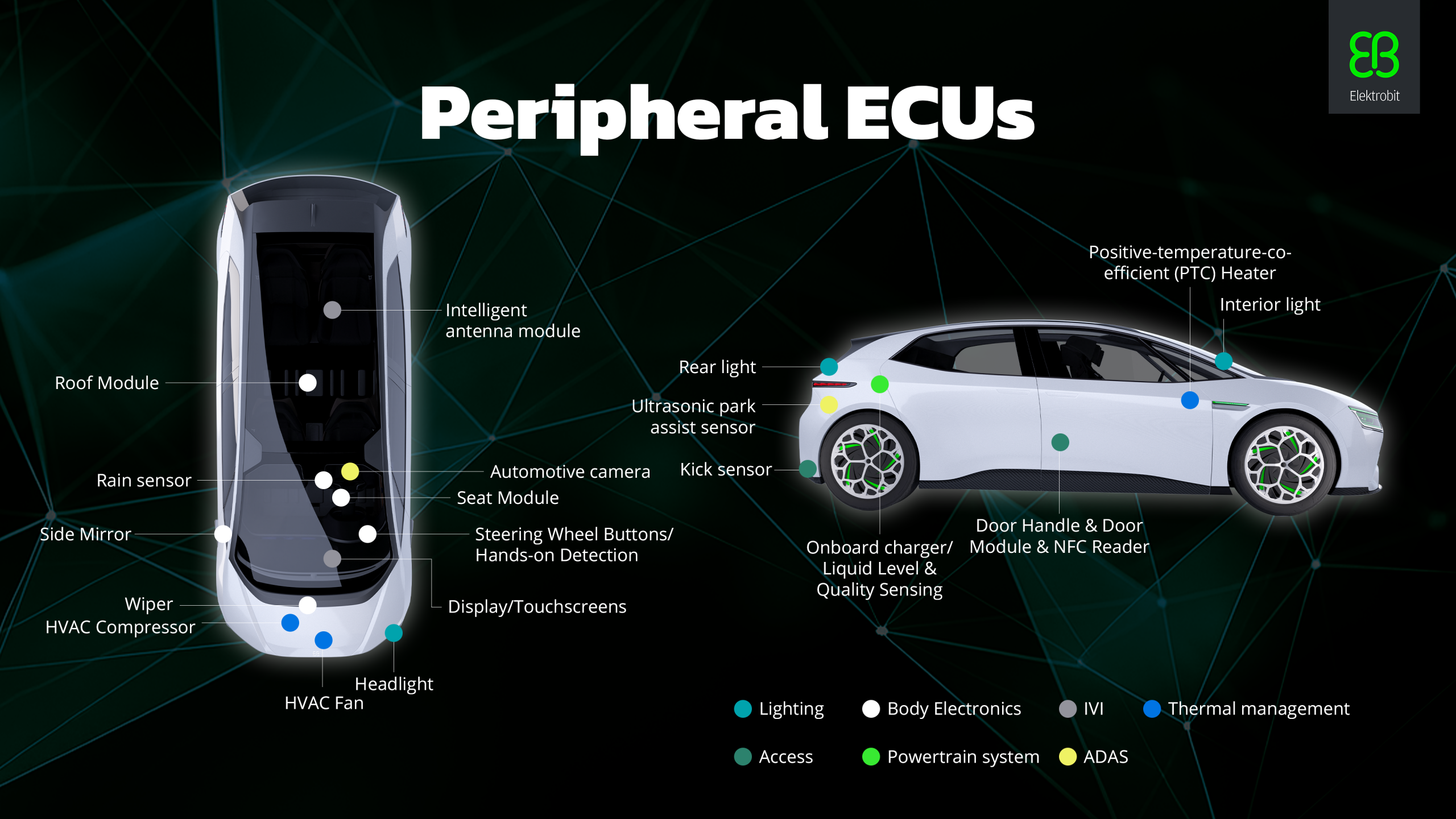
It starts with the little things.
You step into your car on a rainy Tuesday morning. The wipers kick in automatically. The seat shifts into your perfect position. The cabin warms just the way you like it. You didn’t press a single button, and yet, everything feels intentional, as if the car already knew what you needed.
This seamless experience isn’t just the work of cloud computing or AI. Behind the curtain are the true unsung heroes of smart mobility: end nodes, also known as I/O modules or sometimes peripheral ECUs.
These small, distributed computing units are transforming the driving experience from reactive to intuitive. And they’re doing it quietly, embedded throughout the vehicle, handling tasks that drivers might never notice, until something goes wrong.
What are end nodes, really?
End nodes are often described as the “senses and limbs” of a smart system. In a vehicle, these are smart sensors and actuators located throughout the vehicle. They gather data from the physical environment, execute specific functions, and communicate with more powerful controllers, such as zone ECUs, which handle the main logic and decision-making, dependent on the functionality with or without instructions from a central brain.
Think of the rain sensor on your windshield, the motor adjusting your seat, or the camera tracking the lane lines on the road. These devices do more than transmit data, they enable fast, reliable communication between the physical world and the vehicle’s central systems.
This same concept exists beyond the car, too. Your smart thermostat adjusts the temperature based on ambient readings. Your fitness tracker monitors your sleep. Your video doorbell notifies you when a package arrives, and may even unlock the door. End nodes are already all around us, operating quietly, reliably, and autonomously.
The role of end nodes in modern vehicles
Today’s cars are filled with end nodes performing a variety of specialized sensing and actuation tasks. Ultrasonic sensors guide you into a tight parking spot. Kick sensors open the trunk when your hands are full. Cameras and radar support lane keeping and emergency braking. Seat modules remember your preferences, down to lumbar support.
What makes these components remarkable is how they’re evolving. In a software-defined vehicle, end nodes are no longer just passive hardware. They are software-enabled interfaces reliably executing specific functions and communicating with more powerful controllers, such as zone ECUs. They are intelligent devices, mini computers with dedicated software. Depending on the functionality, they are capable of decision-making with or without the instruction from the central brain, providing real-time responsiveness.
Real-world use cases: safety and scalability
How many of us have had the unfortunate experience of having your finger shut in a car window? Well, take for example, the anti-pinch feature in a power window. If a hand or object is in the path while the window is closing, the sensor detects resistance and instantly triggers the motor to reverse. Behind the scenes the anti-pinch functionality continuously monitors the current flow in the window motor. If the window or door motor suddenly draws more current than expected, indicating resistance, an obstruction is assumed, and motor direction is reversed.
This safety-critical action happens locally, without relying on a central computer to process and respond. It’s a small action that can prevent serious injury, and a textbook example of an intelligent end node doing exactly what it was designed to do.
Another example is the NFC reader, which is integrated into the door handle alongside the NFC antenna. This setup enables secure, short-range wireless communication between vehicles and devices such as smartphones, smartwatches, or smart cards. The NFC reader functions as a peripheral end node with minimal local processing capabilities. It supports modern access systems by offloading most of the application logic to a centralized or remote system, ensuring both efficiency and scalability.
Why distributed intelligence matters
The shift toward software-defined architectures has led to a more modular vehicle design. While the main logic resides in zone controllers, distributing sensing and actuation across the vehicle still brings major benefits.
By assigning specific tasks to end nodes, like sensing pressure, detecting motion, or controlling a motor, automakers can:
- Simplify wiring and reduce vehicle weight.
- Standardize components across platforms.
- Accelerate development by decoupling hardware and software responsibilities.
This modularity allows Tier 1 suppliers to develop and validate components in parallel, independent of OEM constraints, improving efficiency and reducing time to market.
The power behind the scenes: software
Even though end nodes don’t run complex logic, the software they do run is essential. It ensures that data is captured accurately, formatted correctly, and transmitted reliably to the zone controller. It also ensures that actuation commands are executed precisely and safely.
This software must meet strict automotive standards such as ISO 26262, especially for safety-critical applications. And while end nodes themselves may not be updated frequently, having a standardized, production-grade software stack simplifies integration and long-term maintenance.
Just as importantly, this approach is cost-effective. By using lightweight, reusable software components across multiple vehicle platforms, OEMs and Tier 1s can reduce development time, avoid duplication of effort, and minimize the need for expensive hardware upgrades. It’s a smart way to scale innovation without scaling cost.
EB tresos AutoCore Light: built for smart sensors & actuators, end nodes and peripheral ECUs
This is where Elektrobit makes a difference. EB tresos AutoCore Light is a lightweight, production-grade software stack designed specifically for smart sensors and peripheral ECUs. It provides Tier 1s and OEMs essential cost-effective software infrastructure needed to:
- Ensure reliable communication with zone controllers.
- Support safety and compliance requirements.
- Minimize memory and compute overhead in resource-constrained devices.
Whether it’s for a rain sensor, a lighting controller, or a door module, EB tresos AutoCore Light helps build robust, compliant, and efficient end nodes that integrate seamlessly into the broader vehicle architecture, where responsiveness and reliability are mission-critical.
The road ahead
Vehicles are becoming more connected, autonomous, and electric, and the importance of end nodes will only grow. They’re not just small parts of a larger machine, they’re the foundational layer of the software-defined vehicle.
The next time your car adjusts the cabin to your preferences or reacts to road conditions before you do, remember: it’s not magic. It’s the result of smart design, smart software, and smart nodes working quietly in concert. They may be small, but they’re leading the automotive revolution, one seamless moment at a time.
Related content:
Learn more about EB tresos AutoCore Light here
Webinar: Lean into the future: Lightweight software for SDV-ready peripheral ECUs
Try EB tresos for free
Your entry into the world of Classic AUTOSAR.






